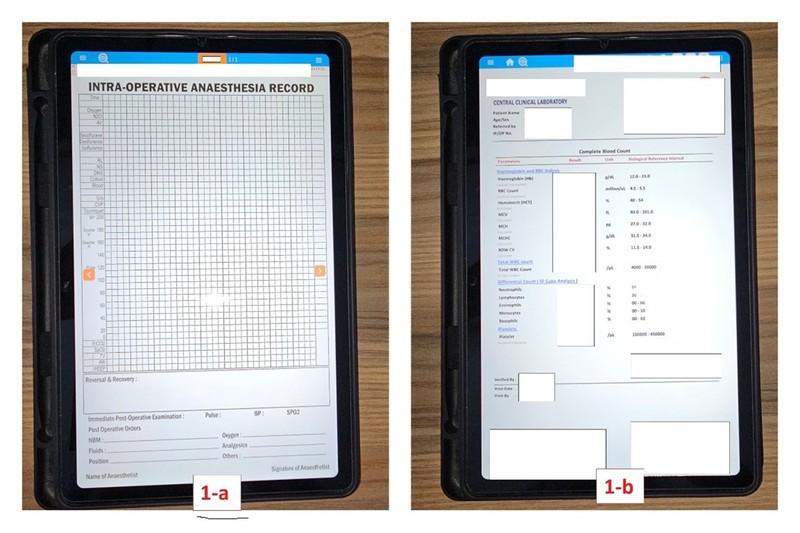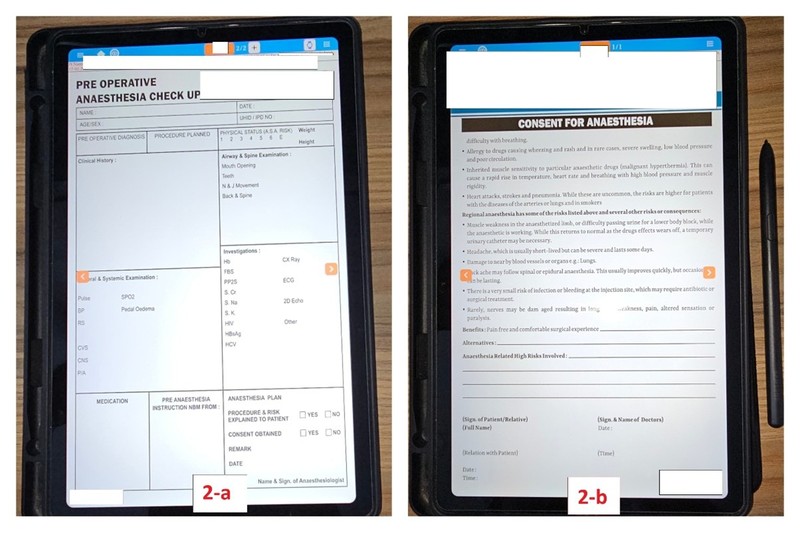Article on Enhancing Anaesthesiology Workflow through Electronic Medical Records: A Case Study
M3 India Newsdesk Jun 09, 2025
This article explores how EMRs are transforming anaesthesiology in a leading teaching hospital in Gujarat, improving patient care and workflow efficiency. It also highlights the long-term benefits, challenges, and prospects of EMR integration in Indian healthcare.

The integration of Electronic Medical Records (EMRs) into healthcare systems has revolutionised the management of patient information, particularly in specialised fields such as anaesthesiology. EMRs serve not only as repositories of patient data but also as tools that enhance clinical workflows and educational opportunities for healthcare professionals [1,2].
This article reviews the implementation and impact of EMRs in the anaesthesiology department of a 750+ bedded teaching hospital in Gujarat, India, focusing on their role in improving workflow efficiency and patient care.
Current Status of EMR Use in India
In India, the adoption of EMRs has been gradual, with significant variations across regions. Gujarat, India, has emerged as a leader in this transition, with our hospital being among the few medical colleges in the state to implement a comprehensive paperless EMR system over the past two years [3,4]. This initiative has been driven by the need for improved patient care, operational efficiency, and compliance with national health policies promoting digital health records.
Information about EMR and EHR: Differences and Similarities
EMRs and Electronic Health Records (EHRs) are often used interchangeably, yet they have distinct functionalities. EMRs are digital versions of paper charts in a clinician's office, primarily used for diagnosis and treatment within a single healthcare organisation [5]. In contrast, EHRs are designed to be shared across different healthcare settings, providing a more comprehensive view of a patient's health history [6]. Both systems aim to enhance patient care, but EHRs offer broader interoperability and data sharing capabilities [1].
Applications of EMR in Anaesthesiology
The implementation of EMRs in anaesthesiology has transformed various aspects of patient care, enhancing efficiency and accuracy across multiple phases of the surgical process. The applications of EMRs can be categorised into three primary phases: preoperative, intraoperative, and postoperative.
Preoperative Phase: EMRs facilitate comprehensive preoperative assessments by allowing anaesthesiologists to access and document patient histories, allergies, and previous anaesthesia experiences efficiently. (Figure 2) .This includes obtaining informed consent digitally, which can be stored and retrieved easily, ensuring compliance with legal and ethical standards [7].
Additionally, EMRs enable the integration of clinical decision support systems (CDSS) that can alert anaesthesiologists to potential drug interactions or contraindications based on the patient's medical history [8].
The ability to capture important images, such as radiographs or lab results, directly into the EMR system enhances the preoperative evaluation process, ensuring that all relevant data is available at the point of care [9].

Figure 1: 1-a: Shows intraoperative events table, 1-b: Blood reports

Figure 2: 2-a: Pre anaesthetic checkup PAC card, 2-b: Consent form
Intraoperative Phase: During surgery, EMRs provide real-time documentation capabilities, allowing anaesthesiologists to record anaesthesia charts and notes seamlessly (Figure 1). This digital documentation improves communication among the surgical team and ensures that critical information is readily available [10].
The EMR system can also integrate with monitoring devices, automatically updating patient vitals and anaesthesia administration records, which reduces the risk of human error and enhances patient safety [10]. Furthermore, the ability to access previous patient records and ongoing lab results during surgery allows for informed decision-making in real-time, improving the overall quality of care [11].
Postoperative Phase: After surgery, EMRs streamline the documentation of postoperative notes and recovery assessments. This ensures continuity of care and facilitates follow-up evaluations [7]. The EMR system allows for easy retrieval of patient data, which is crucial for assessing recovery progress and managing any complications that may arise postoperatively. Additionally, the integration of EMRs with billing systems enhances the efficiency of administrative processes, reducing delays in patient discharge and billing [10].
Overall, the applications of EMRs in anaesthesiology not only enhance clinical workflows but also contribute to improved patient outcomes through better data management and communication.
Long-Term Advantages and Medicolegal Protections
The long-term advantages of adopting EMRs in anaesthesiology extend beyond immediate workflow improvements. One significant benefit is the enhancement of data integrity and security. EMRs provide robust protection against data tampering and loss, ensuring that patient records are accurate and reliable [7]. This is particularly important in the context of medicolegal protections, where accurate documentation can be critical in defending against claims of malpractice or negligence [11].
Moreover, the transition to EMRs facilitates compliance with regulatory requirements and standards for medical record-keeping, which can protect healthcare providers from legal liabilities [11]. The ability to maintain comprehensive and easily retrievable records supports healthcare providers in demonstrating adherence to best practices and protocols, which is essential in legal contexts [11].
Additionally, EMRs contribute to improved patient safety by reducing the likelihood of medical errors associated with paper-based records, such as misinterpretation of handwritten notes or loss of documentation [10]. The integration of clinical decision support tools within EMRs further enhances patient safety by providing alerts and reminders about potential risks, thereby promoting better clinical decision-making [10].
In summary, the long-term advantages of EMRs in anaesthesiology include enhanced data security, improved patient safety, and robust medicolegal protections, all of which contribute to a higher standard of care.
Discussion
The implementation of EMRs in anaesthesiology represents a significant advancement in healthcare delivery, particularly within the context of a 750+ bedded teaching hospital in Gujarat, India. The transition from traditional paper-based records to digital systems has brought about numerous benefits, but it also presents challenges that must be addressed to maximise the potential of EMRs.
One of the most notable advantages of EMRs is the improvement in workflow efficiency. The ability to access patient records instantly and document care in real-time reduces the time spent on administrative tasks, allowing anaesthesiologists to focus more on patient care [10]. This is in stark contrast to the old-school paper-and-pen approach, which is often time-consuming and prone to errors. The integration of EMRs with other hospital systems, such as laboratory and imaging services, further streamlines processes, enabling quicker decision-making and enhancing patient outcomes [10].
However, the transition to EMRs is not without its challenges. Issues such as the initial costs of implementation, the need for comprehensive training for staff, and potential resistance to change among healthcare professionals can hinder the successful adoption of EMRs [9]. Moreover, ensuring data security and protecting patient privacy are paramount concerns that must be addressed through robust cybersecurity measures and adherence to legal standards [11].
In terms of educational impact, EMRs serve a dual role by not only enhancing clinical practice but also providing valuable learning opportunities for medical students and residents. Exposure to EMR systems during training equips future healthcare providers with essential skills for navigating modern healthcare environments [12]. Integrating EMRs into educational curricula can foster a culture of digital literacy among healthcare professionals, ultimately benefiting patient care [12].
Furthermore, the usability of EMRs is a critical factor influencing their effectiveness. Studies have indicated that while EMRs can streamline workflows, they may also disrupt clinical processes and increase documentation time. Therefore, it is essential to continuously evaluate and optimise EMR systems to ensure they meet the needs of healthcare providers and enhance rather than hinder clinical workflows [13].
Future Prospects of EMR and Scope of Adaptability by Other Healthcare Bodies:
The future of Electronic Medical Records (EMRs) appears promising due to technological advancements and growing recognition of their benefits in healthcare delivery. A key development is the integration of EMRs with blockchain technology, which enhances data security and interoperability by providing a decentralised method for storing health records, thus addressing data fragmentation issues.[14]
The ongoing evolution of EMR systems is anticipated to improve user experience and adaptability, leading to increased adoption as healthcare providers acknowledge their role in enhancing care quality and reducing costs. EMRs are more adaptable than traditional paper records, facilitating quality improvement programs.
Healthcare organisations, especially in resource-limited settings, are increasingly willing to adopt EMRs, as studies show that their implementation can enhance healthcare delivery efficiency and confidentiality. This trend is expected to alleviate pressure on government health facilities while improving private sector service delivery. Moreover, effective EMR implementation can enhance health surveillance and service evaluation, ultimately benefiting public health management. EMRs provide comprehensive data that supports clinical decision-making and improves communication among patient care teams, which is essential for effective healthcare delivery.[15]
In conclusion, the future of EMRs is bright, with opportunities for integration with emerging technologies and increased adaptability across various healthcare settings. As healthcare providers continue to embrace digital transformation, EMRs will play a pivotal role in enhancing patient care and improving the efficiency of healthcare systems globally.
Disclaimer- The views and opinions expressed in this article are those of the author and do not necessarily reflect the official policy or position of M3 India.
About the author of this article: Dr Ashish P Jain is an MD Anaesthesia, working as an Associate Professor in Anaesthesiology at Parul Institute of Medical Sciences and Research, Vadodara, Gujarat.
-
Exclusive Write-ups & Webinars by KOLs
-
Daily Quiz by specialty
-
Paid Market Research Surveys
-
Case discussions, News & Journals' summaries